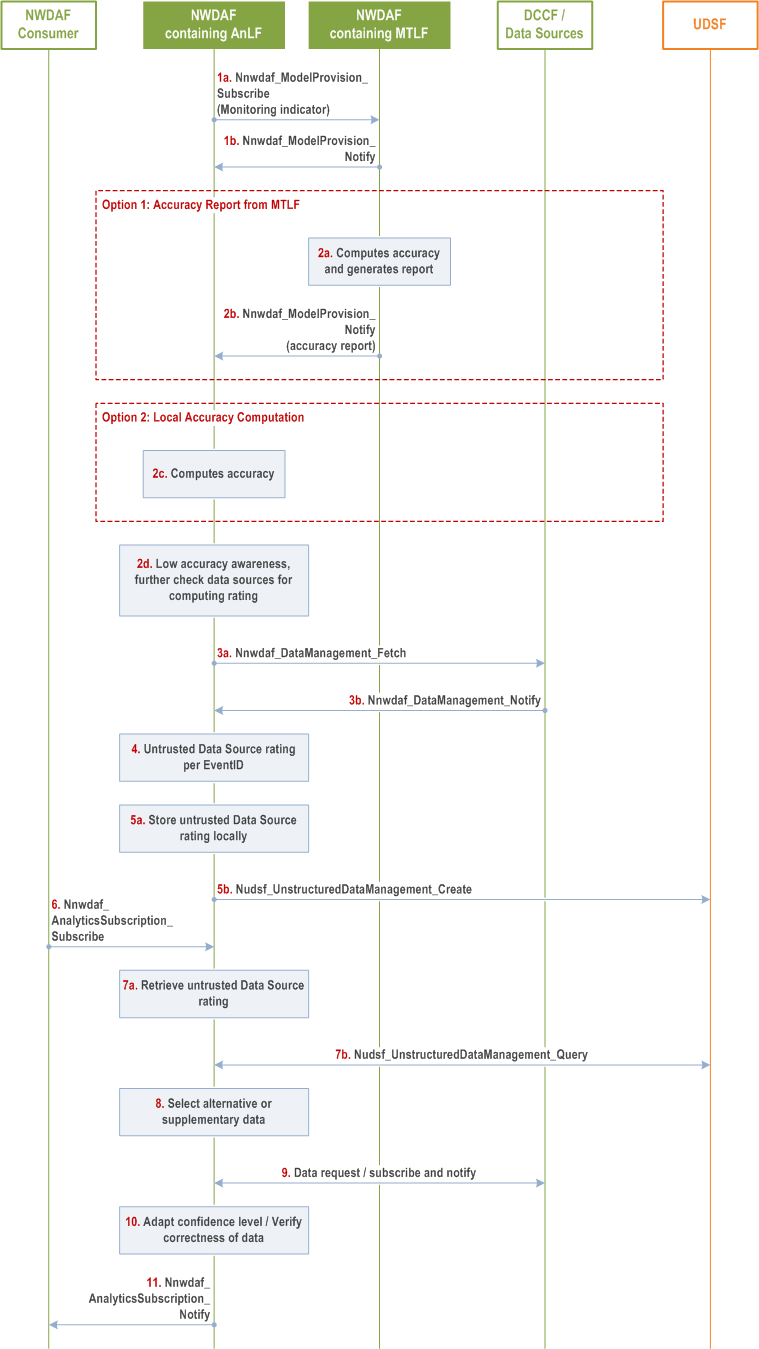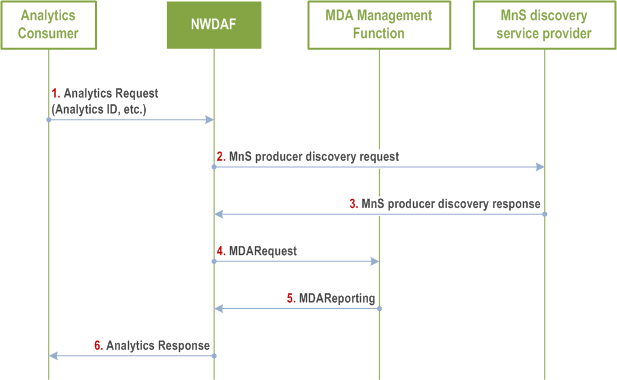Content for TS 23.288 Word version: 18.6.0
1…
4…
5…
5A…
6…
6.1.3
6.1.4…
6.1.4.4…
6.1.5…
6.1A…
6.1B…
6.1B.2.3…
6.1C
6.2…
6.2.3…
6.2.6…
6.2.6.2
6.2.6.3…
6.2.6.3.3
6.2.6.3.4
6.2.6.3.5
6.2.6.3.6…
6.2.7…
6.2.8…
6.2.9…
6.2.13…
6.2A…
6.2B…
6.2B.3
6.2B.4…
6.2C…
6.2D…
6.2E…
6.2F…
6.3…
6.4…
6.5…
6.6…
6.7…
6.7.3…
6.7.4…
6.7.5…
6.8…
6.9…
6.10…
6.11…
6.12…
6.13…
6.14…
6.16…
6.17…
6.18…
6.19…
6.20…
6.21…
7…
7.4…
7.7…
7.9…
8…
9…
10…
6.2.13 Rating untrusted AF data sources
6.2.13.1 General
6.2.13.2 Procedure for rating untrusted AF data sources
6.2.14 Analytics Collection from MDAF
6.2.14.1 General
6.2.14.2 Procedure for analytics collection from MDAF
...
...
6.2.13 Rating untrusted AF data sources |R18| p. 117
6.2.13.1 General p. 117
When using an untrusted AF as data source, NWDAF may consider the data source rating results. The rating of untrusted AF is based on the quality of data collected.
Such rating may be triggered when the accuracy check based on the calculation between the predicted and ground-truth data indicates low performance, while the untrusted data source rating may be performed based on NWDAF internal logic. In the selection of the appropriate data sources, the NWDAF may use the rate of untrusted AF data sources as a criterion to calculate the expected confidence degree.
6.2.13.2 Procedure for rating untrusted AF data sources p. 117
The process of rating untrusted AF data sources is depicted in Figure 6.2.13.2. For realizing potential issues, the NWDAF containing AnLF subscribes to the NWDAF containing MTLF, which performs an accuracy calculation based on the predicted and ground-truth data or alternatively the NWDAF containing AnLF can calculate the accuracy locally by comparing the predicted and ground-truth data.

Step 1.
Option 1: Accuracy report from NWDAF containing MTLF
NWDAF containing AnLF subscribes to NWDAF containing MTLF for obtaining an ML Model using the Nnwdaf_ModelProvision_Subscribe service operation. The NWDAF containing AnLF may include a threshold (as described in clause 6.2E.2) to indicate when the NWDAF containing MTLF needs to execute the accuracy monitoring operations.
Step 2a.
Option 2: NWDAF containing AnLF computes accuracy
NWDAF containing MTLF evaluates the ML Model Accuracy according to clause 6.2E.2.
Step 2b.
An accuracy report is sent to the NWDAF containing AnLF, e.g. when the reporting threshold is met by invoking Nnwdaf_MLModelProvision_Notify service operation.
Step 2c.
NWDAF containing AnLF calculates the accuracy by comparing the predictions with ground truth data.
Step 2d.
Either step 7a or step 7b is executed, before collecting the data needed for the subscribed Analytic ID.
NWDAF containing AnLF is aware that the ML Model used has a low accuracy either by receiving the accuracy report in step 2b or monitoring the accuracy by itself in step 2c. NWDAF containing AnLF determines that it needs to check further the data sources and compute data source rating. The decision conditions upon which it needs to initiate data source rating for a data source is based on NWDAF containing AnLF implementation.
Step 3a-3b.
NWDAF containing AnLF initiates rating of a data source by requesting and receiving supplementary data, i.e. via Nnwdaf_DataManagement_Fetch / Ndccf_DataManagement_Notify , from different data sources (if available) to verify the data source quality or correctness. Such data can be for example performance data from the OAM which are supplementary to the data from untrusted AFs, or data from UPF supplementary to the data from untrusted AFs.
Step 4.
NWDAF containing AnLF updates the rating for the sources where untrusted data is deviated from the supplementary trusted data per Event ID.
Step 5a.
NWDAF containing AnLF stores the untrusted AF data source rating locally.
Step 5b.
NWDAF containing AnLF may send the untrusted AF data source rating to UDSF, if available. NWDAF containing AnLF uses the Nudsf_
Step 6.
A NWDAF consumer subscribes to a certain Analytics ID, using Nnwdaf_AnalyticsSubscription_Subscribe service operation.
Step 7a.
In the case of ML Model (re)training, if the NWDAF containing MTLF is the same NWDAF containing AnLF in step 5b, it may also use the rate of untrusted AF data sources by performing steps 7b and 8-9 and then, (re)trains the ML Model.
The NWDAF containing AnLF retrieves the untrusted AF rating of the data sources locally.
Step 7b.
The NWDAF containing AnLF retrieves the untrusted AF rating of the data sources from the UDSF using the to use Nudsf_
Step 8.
If the rating of one or more untrusted AF is below a threshold (i.e. that is pre-configured), then the NWDAF containing AnLF can:
Step 9.
- select an alternative untrusted AF (if available) with higher rating; or
- request supplementary data from other trusted data sources.
The NWDAF containing AnLF subscribes to a new data source to receive alternative or supplementary data if a new data source is selected in step 8.
Step 10.
The NWDAF containing AnLF may use the rate of untrusted AF data sources as a criterion to calculate the confidence level of the respective analytics output.
Step 11.
The NWDAF containing AnLF provides the analytics output to the analytics consumer, using the Nnwdaf_AnalyticsSubscription_Notify service operation.
6.2.14 Analytics Collection from MDAF |R18| p. 119
6.2.14.1 General p. 119
The MDA functional overview and service framework as defined in Figure 5.1-1 of TS 28.104 is used by NWDAF to trigger the MDA MnS to request analytics from the MDA Management Function (MDAF).
Before NWDAF requests analytics from the MDA Management Function, the NWDAF discovers the MDA Management Function via the MnS discovery service producer as defined in clause 5 of TS 28.537.
6.2.14.2 Procedure for analytics collection from MDAF p. 120

Precondition:
Initially MDAF(s) or MDA MnS producers register their capabilities, i.e. MnS information or MnS profile as described in clause 5 of TS 28.537 to a MnS discovery service producer. The MnS discovery service producer may contain all or partial information related to the capabilities of MDA MnS producer.
Step 1.
An analytics consumer issues a request or subscription of network analytics towards the selected NWDAF as described in clause 6.1.
Step 2.
NWDAF discovers the MDA Management Function from the MnS discovery service producer by sending a MnS producer discovery service operation.
Step 3.
The MnS discovery service producer provides the relevant MnS information of the MDA Management Function to the NWDAF.
Step 4.
If the MnS information of more than one MDAF is received, NWDAF selects the most suitable MDAF and gets the address of the selected MDAF from the MnS information. Then NWDAF sends analytics request to the MDA Management Function by triggering a MDARequest service operation as defined in clause 9.3.2 of TS 28.104 requesting management data analytics such as Slice Coverage Analysis, Mobility Performance Analysis, Fault Prediction analysis. The analyticScope may contain Area of interest, Network Slice information, NF type etc.
Step 5.
The MDA Management Function provides the analytics to the NWDAF by triggering an MDAReporting service operation.
Step 6.
NWDAF provides the analytics response back to the analytics consumer after processing the analytics provided by the MDA Management Function together with other data receives from NF sources according to the Analytics ID defined in clause 6.